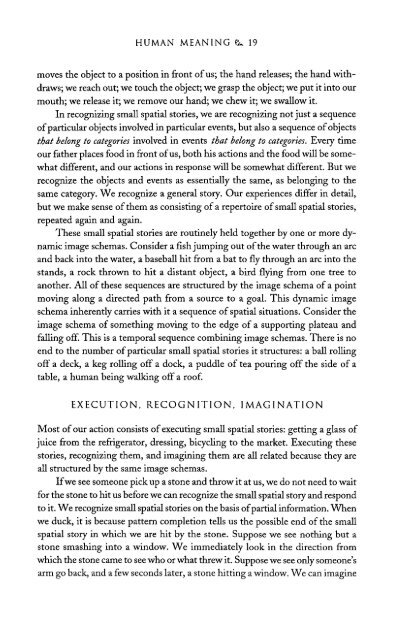The Literary Mind.pdf
The Literary Mind.pdf
The Literary Mind.pdf
Create successful ePaper yourself
Turn your PDF publications into a flip-book with our unique Google optimized e-Paper software.
HUMAN MEANING 19<br />
moves the object to a position in front of us; the hand releases; the hand withdraws;<br />
we reach out; we touch the object; we grasp the object; we put it into our<br />
mouth; we release it; we remove our hand; we chew it; we swallow it.<br />
In recognizing small spatial stories, we are recognizing not just a sequence<br />
of particular objects involved in particular events, but also a sequence of objects<br />
that belong to categories involved in events that belong to categories. Every time<br />
our father places food in front of us, both his actions and the food will be somewhat<br />
different, and our actions in response will be somewhat different. But we<br />
recognize the objects and events as essentially the same, as belonging to the<br />
same category. We recognize a general story. Our experiences differ in detail,<br />
but we make sense of them as consisting of a repertoire of small spatial stories,<br />
repeated again and again.<br />
<strong>The</strong>se small spatial stories are routinely held together by one or more dynamic<br />
image schemas. Consider a fish jumping out of the water through an arc<br />
and back into the water, a baseball hit from a bat to fly through an arc into the<br />
stands, a rock thrown to hit a distant object, a bird flying from one tree to<br />
another. All of these sequences are structured by the image schema of a point<br />
moving along a directed path from a source to a goal. This dynamic image<br />
schema inherently carries with it a sequence of spatial situations. Consider the<br />
image schema of something moving to the edge of a supporting plateau and<br />
falling off. This is a temporal sequence combining image schemas. <strong>The</strong>re is no<br />
end to the number of particular small spatial stories it structures: a ball rolling<br />
off a deck, a keg rolling off a dock, a puddle of tea pouring off the side of a<br />
table, a human being walking off a roof.<br />
EXECUTION, RECOGNITION, IMAGINATION<br />
Most of our action consists of executing small spatial stories: getting a glass of<br />
juice from the refrigerator, dressing, bicycling to the market. Executing these<br />
stories, recognizing them, and imagining them are all related because they are<br />
all structured by the same image schemas.<br />
If we see someone pick up a stone and throw it at us, we do not need to wait<br />
for the stone to hit us before we can recognize the small spatial story and respond<br />
to it. We recognize small spatial stories on the basis of partial information. When<br />
we duck, it is because pattern completion tells us the possible end of the small<br />
spatial story in which we are hit by the stone. Suppose we see nothing but a<br />
stone smashing into a window. We immediately look in the direction from<br />
which the stone came to see who or what threw it. Suppose we see only someone's<br />
arm go back, and a few seconds later, a stone hitting a window. We can imagine















